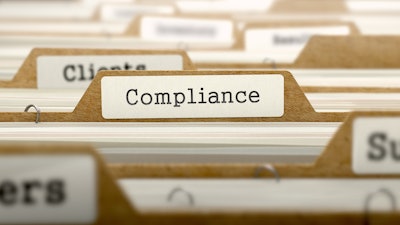
Demands for greater ESG transparency and environmental stewardship are rising, fueled by public awareness of climate change, social and ethical issues. In line with this increased awareness, the EU has been designing and will soon be enforcing a series of regulations devised to ensure that businesses run more sustainable and ethical operations and that they are transparent in reporting their efforts.
Even businesses not actually based in the EU will need to comply with these regulations if they wish to continue to provide their products or services to member states. Here are some of the major regulatory hurdles to look out for in 2025 for companies operating and trading with the EU.
EU CSRD
On Jan. 1, 2024, the EU Corporate Sustainability Reporting Directive (CSRD), requiring all large companies on the EU market to disclose information on what they see as the risks and opportunities arising from social and environmental issues, came into effect. Businesses must also define the impact of their activities on people and the environment. The requirement affects all listed companies with the exception of listed micro-enterprises and is being rolled out over 4 years with estimates suggesting it will eventually impact over 50,000 companies.
Non-EU companies will also have to report if they generate over EUR 150 million on the EU market. As such, an estimated 10,000 non-EU companies are likely to be directly impacted by the directive, with nearly a third coming from the United States.
The new rules are designed to ensure that stakeholders can make more informed decisions with access to information around the impact of companies on the environment and the risks and opportunities arising from their performance. Also, CSRD and the European Sustainability Reporting Standards that are the basis for reporting will help with the standardization of non-financial reporting improving the compatibility of non-financial performances of companies. The first group of companies will have to apply the new rules for the first time in the 2024 financial year, but moving forward all businesses will need to ensure that they have the tools in place for reporting. These will include both accurate and transparent systems to measure, monitor and verify the emissions that are being reported.
EU CSDDD
The EU Directive on corporate sustainability due diligence (Directive 2024/1760) entered into force on July 25, 2024. Member States have until July 26, 2026 to transpose the directive into national law. The rules will start to apply to affected companies from 2027 following a staggered approach until full application in July 2029.
The aim of the directive is to foster sustainable and responsible corporate within company operations at the same time encompassing their global value chains. The regulation takes stock of the interconnected and global nature of the supply chain and require that businesses identify and address ethical and environmental impact of their decision even outside the boundaries of the EU.
The Corporate Due Diligence Duty thus established by this directive therefore requires that businesses identify and address potential human rights and environmental impacts in: their own activities, those of their subsidiaries, those of Tier 2 and Tier 3 suppliers. This type of visibility is as yet quite rare for businesses so they will have to invest in systems that streamline the collection and analysis of this wide-reaching data, including that pertaining to transportation, storage and distribution means, in order to help them provide accurate reporting without overburdening internal resources or suppliers themselves with endless forms and certificate uploading.
While the CSDDD is an EU instrument, its impact is designed to be global and businesses providing EU companies or their suppliers with goods will also need to ensure they are able to provide the required information.
In addition to EU CSDDD companies will need to address the requirements of EU CSRD which includes end-user and product disposal reporting.
Scope 3 emissions
Within CSRD reporting, special focus is afforded to Scope 3 emissions, those not generated directly by activities from assets owned or controlled by the organization but from the supply chain it relies on and indirectly affects through its purchasing decisions.
With a double materiality approach at the heart of CSRD reporting, businesses will need to be transparent in their assessment of both how sustainability issues impact their financial performance and activities, as well as how their operations impact the society and environment in which they operate, and extend this evaluation to their Scope 3 emissions. As these are generated upstream and downstream in the supply chain it is critical that reporting boundaries are opened wide, requiring a more thorough, extensive and efficient assessment.
EU Deforestation Regulation
The new EU regulation on deforestation-free products is the latest in a string of measures developed specifically to demand greater accountability from traders and operators in goods such as leather, chocolate, tires or furniture. As of Dec. 30, 2025, when the new law enters applications, businesses will be required to prove that their products do not derive from recently deforested land and have not contributed to forest degradation. To be able to do this, businesses will need to radically change the way they manage their suppliers, demanding greater transparency and frequently monitoring status changes and certifications.
For example, if suppliers are sent automatic reminders for supporting certifications and documentations, this reduces the burden on procurement staff, but combining this automation with self-service portals where they can automatically upload documents and information will also help ensure that suppliers do not feel the burden becomes too much to bear.
Similarly, automation can support in the contract draft and red-lining stage by automatically introducing clauses for measure that ensure compliance with the deforestation regulation. Automatic revision of existing clauses will also save procurement staff a lot of energy and drive down the risk of human error. By lightening the admin effort required, supply chain managers will be able to focus their resources on engaging with their partners to find alternative sources and solutions.
Conclusion
The ripple effects of these different regulations will be felt along the supply chain with intermediaries around the world also finding that they need to improve their assessment of suppliers and audit their claims more frequently to remain appealing alternative in the market. As a result, the amount of supply chain data produced and shared is likely to significantly increase.
To manage the new requirements and the data needed to support it, businesses in a range of sectors will need to introduce additional data sources and operations into their procurement operations. To avoid excessively increasing the burden on staff and suppliers it would be advisable to leverage automation tools and self-service portals that will streamline these new procedures.
As many companies report that they lack the resources, tools and in-house capacity needed to build a procurement program capable of effectively collecting supplier sustainability data, it is critical that those operating in and/or trading significantly with Europe timely implement efficient solutions to collect, analyze and report necessary data as well as manage all relevant risks.



















